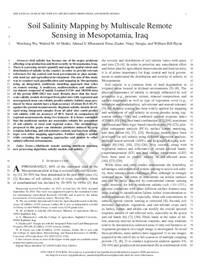Soil Salinity Mapping by Multiscale Remote Sensing in Mesopotamia, Iraq

Authors:
Soil salinity has become one of the major problems affecting crop production and food security in Mesopotamia, Iraq. There is a pressing need to quantify and map the spatial extent and distribution of salinity in the country in order to provide relevant references for the central and local governments to plan sustainable land use and agricultural development. The aim of this study was to conduct such quantification and mapping in Mesopotamia using an integrated, multiscale modeling approach that relies on remote sensing. A multiyear, multiresolution, and multisensor dataset composed of mainly Landsat ETM+ and MODIS data of the period 2009-2012 was used. Results show that the local-scale salinity models developed from pilot sites with vegetated and nonvegetated areas can reliably predict salinity. Salinity maps produced by these models have a high accuracy of about 82.5-83.3% against the ground measurements. Regional salinity models developed using integrated samples from all pilot sites could predict soil salinity with an accuracy of 80% based on comparison to regional measurements along two transects. It is hence concluded that the multiscale models are reasonably reliable for assessment of soil salinity at local and regional scales. The methodology proposed in this paper can minimize problems induced by crop rotation, fallowing, and soil moisture content, and has clear advantages over other mapping approaches. Further testing is needed while extending the mapping approaches and models to other salinity-affected environments.
